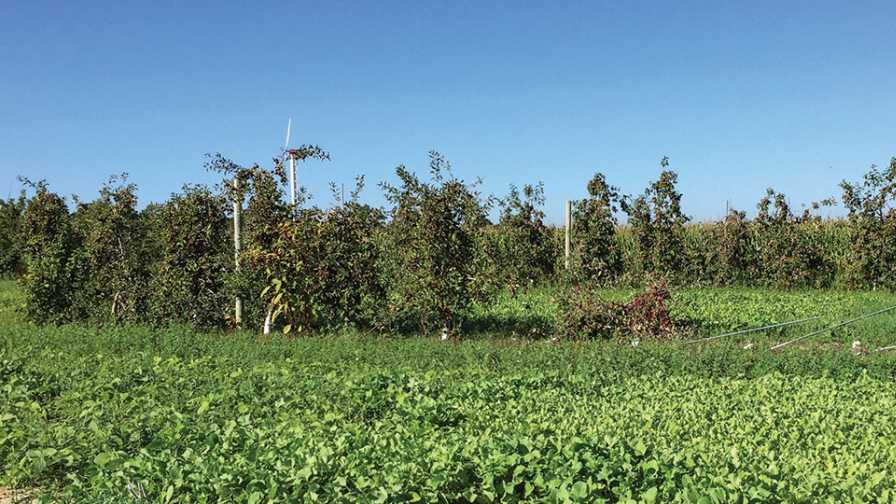Scientists Strive to Save Apple Orchards From Replant Disease

Michigan Apple Replant Project experimental plots at the Clarksville Research Center in late August 2018. In the foreground is one of the black oat cover crop plots, with an oilseed radish cover crop plot just beyond it, and in the background a couple of immediate replant plots. Photo by Julianna K. Wilson
Crop losses are the ultimate nightmare for growers. There are few things scarier than losing the lifeblood that is the yearly crop. With replant disease flaring up in orchards throughout the country — and little information to diagnose or remedy the situation — crop losses are a real concern.
The disease is somewhat mysterious, but it appears to manifest when new plantings intersect areas previously occupied by older plantings of a related species. In apple orchards this often occurs when a grower tries to transition an older orchard with low-density plantings to a high-density orchard. The smaller row spacing and smaller trees and roots means growers are more likely to see problems in the replanted rows.
In Michigan, a few factors have the potential to make the replant disease problem more pronounced. The biggest issue is that most of the prime real estate for apple orchards is already taken. According to Julianna K. Wilson, an Entomologist and Tree Fruit IPM Outreach Specialist at Michigan State University (MSU), sites with optimum slope and minimal frost damage are either already in orchard production or are being encroached on by urban development.
“This means growers are more likely to replant old orchards. When they replant into old rows, they are more likely to see issues in those areas,” Wilson says. “Growers are investing a lot of money in these new orchards, and we want them to succeed.”
Looking for Solutions
While there aren’t numbers to indicate how widespread replant disease is in Michigan, Wilson is working on a project to evaluate the problem. Funded in part by MSU’s Project GREEEN, the Michigan Apple Committee, and the Michigan Tree Fruit Commission, the study has two main objectives: identifying the main factors of replant disease in Michigan by looking at farm soils; and replicating a trial of the best management practices in order to inform future research on the topic.
The first objective was completed using a farm soil survey. After 12 grower/collaborators who farm the state’s renowned Fruit Ridge were identified, the team sampled soils from 20 blocks with 45 different rootstock and scion combinations. Researchers looked at the soils, studying both the physical and biological components.
The survey unearthed information on everything from soil type, nutrient levels, and composition, to the microbial community within the dirt. The microbial community includes nematodes, mycorrhizal fungi, oligochaetes, bacteria, oomycetes, and other fungi — all of which would be helpful in determining whether certain microorganisms associated with replant disease were present in the soils.
Armed with this information about the soil health in each orchard block, the research team wrote up a report and made specific recommendations to each grower about how to proceed with the replant process. One suggestion, for example, was to wait one year before replanting.
Because growers generally must order apple trees three years in advance, Wilson says many want to replant as soon as possible to maximize their return on investment, which might determine how some growers decide to proceed. No matter what the growers decide, Wilson says the team plans to follow up with each collaborator this spring to see what they decided and how everything went.
Clarksville Trial
To delve into the second objective, the researchers set up an experiment at the Clarksville Research Center. The team wanted to test out many potential best practices for managing replant disease and chose seven preplant options: fallow, cash crop cover (soybeans), non-host cover (black oats), biofumigant cover (oilseed radish that was planted, mowed, and incorporated as green manure), herbicide-killed (trees killed and removed), herbicide-killed and cover planted (trees killed and removed before black oats were planted), and immediate replant (trees pulled and new ones replanted).
One treatment that’s not on the list: fumigation. Wilson says this is intentional. Research from Mark Mazzola, a USDA-ARS Research Plant Pathologist, indicates that fumigation’s impacts might not last long enough for the orchards to re-establish themselves. Not only does fumigation kill beneficials, Wilson says, it also causes a rebound effect that wouldn’t give growers enough time to get their new trees off the ground. That said, some growers have asked about fumigation, so the research team is trying to decide if it can be added to the experiment. This aspect of the experiment remains to be determined.
For now, there are six replications of each treatment, and all plots will be replanted this spring with ‘Honeycrisp’ either budded to Nic.29 or G.214 rootstocks. Wilson says the project setup has been funded for two years.
The experiment will be evaluated within three to four months and annually throughout the first full year of production. The orchard is projected to be at full production three to five years after the trees are planted.
“The underlying goal is to really know whether we need our own program to look at apple replant in Michigan or if what has been discovered around the world can be applied right away without having to do anything else,” Wilson says. “We’re trying to pull together an Extension set of diagnostics; ‘If you have this, this, and this, then apply XYZ.’”
Ultimately, it’s all about helping growers make better decisions.
“The biggest success,” she says, “will come from giving growers the information they need to get their orchards into production as quickly as they want.”










